Despite a turbulent year caused by the COVID-19 pandemic, enrollment at the University of Illinois Urbana-Champaign remains steady thanks to continued robust on-campus enrollment and the growing demand for online graduate programs.
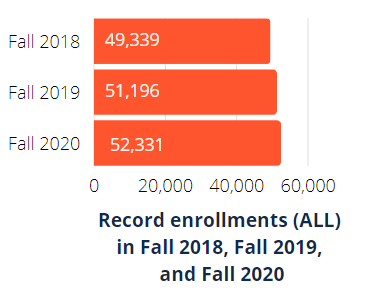
Over the last few years, the university has seen record overall enrollments, including 49,339 in Fall 2018; 51,196 in Fall 2019; and 52, 331 in Fall 2020.
Dan Mann, Associate Provost for Enrollment Management, said that enrollment in graduate programs has been growing steadily.
According to a Division of Management Information report, the Spring 2021 graduate enrollment was 17,987 – a 1.04 percent increase from Fall 2020 and – using
a better comparison – a 13.03 percent jump from Spring 2020.
“I think most of that growth has been online,” Mann said. Graduate College officials confirmed that.
Currently, the U of I offers a combined 291 master’s and doctoral degree programs. Of those, 34 from most academic colleges on campus are online. That doesn’t count a large number of
professional certificate programs.
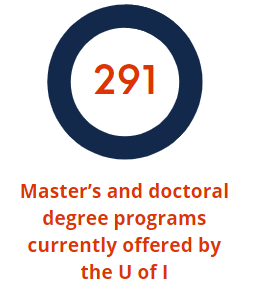

“When I look to see where the growth is really coming from, typically, it is in online programs,” said Beth Spark, Assistant Dean of Admissions, Registration, and Enrollment Services at the Graduate College.
Spark added that the online surge has been driven largely by a handful of scalable programs – the iMBA (Master of Business Administration, from the Gies College of Business) and MCS (Master of Computer Science, from the Department of Computer Science
in the Grainger College of Engineering) being the top two – offered on the Coursera online learning platform.
“We started seeing these huge spikes in enrollment when the iMBA started,” Spark said. “In general, I don’t see our Coursera programs slowing down.”
History of online programming
Illinois’ robust online programming can be traced back to the 1960s, said John Hart, Professor and Director of Online Programs in the Department of Computer Science and Executive Associate Dean at the Graduate College.
That’s when researchers created PLATO (Programmed Logic for Automatic Teaching Operations), recognized as the world’s first computerized learning system. The plasma display, touchscreen, display graphics, online testing, instant messaging,
among other things, were originally developed for or on PLATO.
In 1996, the School of Information Sciences offered the first fully online program -- the LEEP program, offering an online Master of Library and Information Sciences, which continually
has been the top-ranked program of its kind in the nation.
Around 2012, Illinois entered into a partnership with Coursera to offer massive open online courses (MOOCs).
“We were the first land-grant university to offer Coursera MOOCs to the general public,” Hart said, adding people can take MOOCs without enrolling in the university.
However, he pointed out that they’re different from the “for-credit” courses offered to admitted and enrolled students who are required to complete projects, take exams, and fulfill other course requirements that will go toward
course credits and eventually a degree.
“That’s kind of the secret sauce … in order for us to confer a degree,” Hart said, adding that all online students must meet the same admissions and program standards as their on-campus counterparts. “The only difference
(between online and on campus) is that we have greater capacity in some of the online programs than we do on campus.”
In Spring 2016, Illinois launched the iMBA on the Coursera platform.
“It was the first online degree program offered by Coursera,” Hart said. “The reason we did that was MOOCs proved that we could deliver quality education at scale. That allowed us as a land-grant university to deliver degree opportunities
in areas of high demand that we couldn’t accommodate using other means.”
Since then, Spark said three more programs have been launched on Coursera – the MCS, the iMSA (Master of Science in Accountancy), and the iMSM (Master of Science in Management). Learn more about Illinois Coursera programs and courses here.
Enrollment spike
Up through Fall 2016, Spark said enrollment in graduate programs, both on campus and online, accounted for only about 23 percent of the total enrollment.
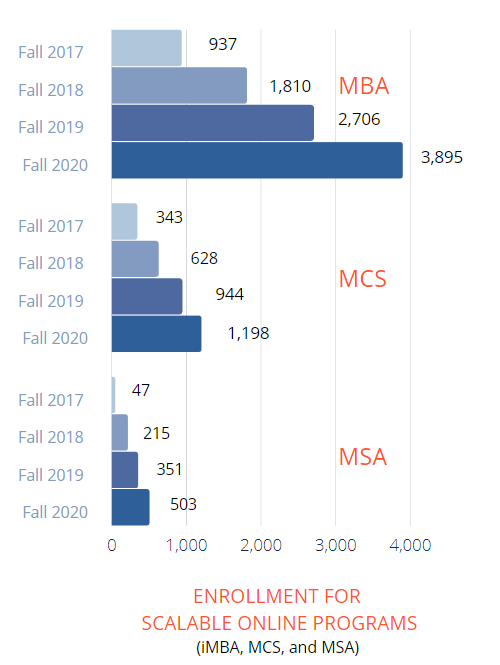
But with the addition of the Coursera programs, enrollment rose to 27 percent in 2017, 29 percent in 2018, 31 percent in 2019, and 34 percent in 2020 with the online iMBA and MCS programs largely driving the uptick.
The iMBA enrollment nearly doubled from Fall 2018 (1,810) to Fall 2019 (2,706) and rose another 43.94 percent in Fall 2020 (3,895).
The MCS enrollment increased 50.32 percent from Fall 2018 (628) to Fall 2019 (944) and 26.91 percent in Fall 2020 (1,198).
Spark and Hart said the other online graduate programs across campus are also growing steadily, although their enrollments are much lower.
While Spark is pleased that the Fall 2020 and Spring 2021 enrollments continue to increase, she cautioned that they must be examined through a COVID-19 lens.
“Enrollments are hard to predict this year based on Fall 2020,” she said, pointing out that many new international students who were enrolled for fall weren’t able to come due to travel restrictions. “Some did choose to enroll
online, but a good number of those students – about 1,800 -- deferred and were admitted for Spring 2021 or Fall 2021”
“For Fall 2020 enrollment, we looked like we had an increase, and we did,” Spark continued. “But this increase is primarily due to our online enrollments. If we had had our typical yield for the fall, it would have been a significantly
larger increase.”
Enrollment and COVID-19
Going back to the DMI report, Hart said the growth of online graduate programs – both on Coursera and standard Learning Management Systems (LMS) – filled the enrollment gap caused by COVID-19.
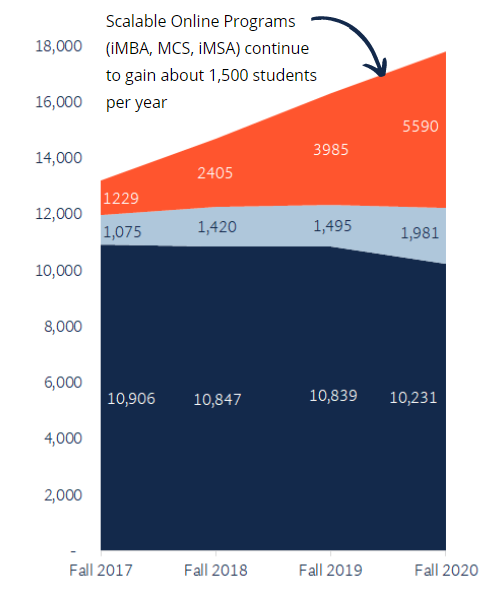
*This image is based on a chart created by John Hart, a Professor and Director of Online Programs in the Department of Computer Science and Executive Associate Dean of the Graduate College. The blue represents on-campus programs, including external classroom programs; the gray represents standard online programs; and the orange represents scalable online programs.
He created a chart, which showed that on-campus programs, including external classroom programs, remained steady but dipped about 6 percent – a loss of 608 students – due to the pandemic. Standard online programs added 480 students in Fall
2020, while scalable online programs continue to gain an average of 1,500 a year.
“We’ve doubled our online enrollment, and that was partially boosted by COVID,” Hart said, adding more minority students have enrolled, as well.
Hart acknowledged that some students who took on-campus classes have struggled to adapt to online or hybrid learning. But others have flourished in the online environment.
“What we discovered with our online classes is we’re reaching students in the state, the nation, and the world that we hadn’t been able to reach before with our standard online … and campus offerings, he said.
He said COVID-19 changed people’s everyday lives regarding home and family, employment, and other responsibilities. And more people discovered that online programs – including newer offerings with asynchronous courses -- offer them the flexibility
they need to meet those responsibilities and continue their education from wherever they are.
“We’re also able to reach the price point,” Hart said. “Tuition is significantly lower for those online scalable degrees. That allows us to reach students who couldn’t afford the full-time tuition, and that’s expanded
our reach to students in lower socio-economic situations. All of those factors have contributed to increasing the diversity of the graduate students at Illinois.”
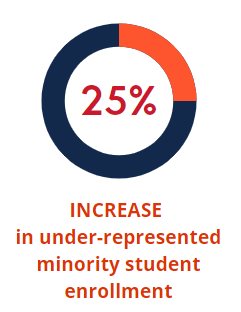
In Spring 2021, under-represented minority student enrollments increased by 25 percent, Spark said.
“When you dive into that, some of these online programs account for most of that increase,” she said. “Specifically, the four Coursera programs account for just shy of 58 percent of that increase. And overall, they account for about
33 percent of our under-represented domestic students. These programs have definitely led in increasing these enrollments.”
Going forward
The university is now in the admissions season for Fall 2021.
Spark and Mann said it’s difficult to predict what will happen with enrollment.
“We constantly do a lot of data analytics,” said Mann, who was pleasantly surprised by a .94 percent undergraduate enrollment increase from Spring 2020 to this spring and counts it as “a victory.
“Unfortunately, we don’t have a model of what to expect in a pandemic … or a period to compare it to," he continued. "We will continue to run our models, but it’s still a bit of a guessing game.”
Spark agreed.
“It’s difficult to determine because some numbers are inflated, some numbers are down,” she said. “It’s going to be an odd year to compare to for a while.”
Regardless, Hart said officials will remain focused on the university’s land-grant mission going forward.
“And we want to make sure that as we’re meeting the needs of the community for this education that we ensure the quality of those degrees … and that all of the requirements for the degree have been met by these methods for offering
the degree,” he said.
For an in-depth look at student enrollment data, go to: https://go.illinois.edu/StudentEnrollment
To learn more about Illinois’ online graduate programs go to the Illinois Online Website.